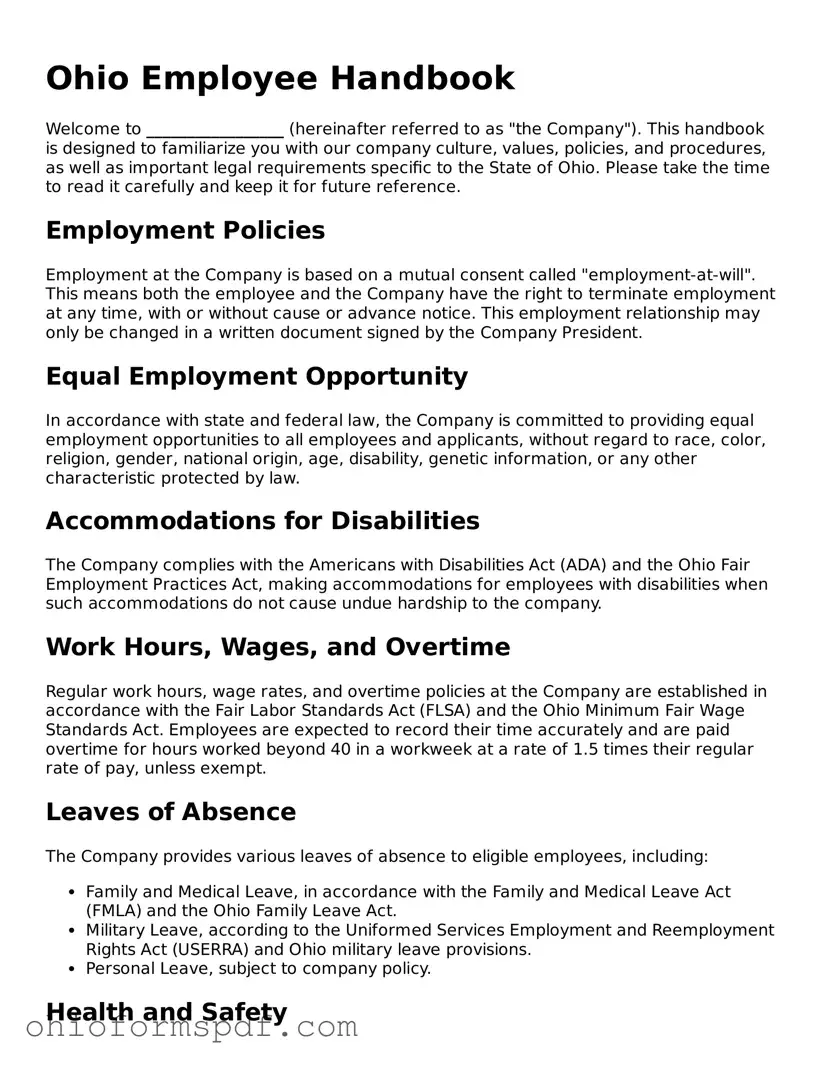Ohio Employee Handbook
Welcome to _________________ (hereinafter referred to as "the Company"). This handbook is designed to familiarize you with our company culture, values, policies, and procedures, as well as important legal requirements specific to the State of Ohio. Please take the time to read it carefully and keep it for future reference.
Employment Policies
Employment at the Company is based on a mutual consent called "employment-at-will". This means both the employee and the Company have the right to terminate employment at any time, with or without cause or advance notice. This employment relationship may only be changed in a written document signed by the Company President.
Equal Employment Opportunity
In accordance with state and federal law, the Company is committed to providing equal employment opportunities to all employees and applicants, without regard to race, color, religion, gender, national origin, age, disability, genetic information, or any other characteristic protected by law.
Accommodations for Disabilities
The Company complies with the Americans with Disabilities Act (ADA) and the Ohio Fair Employment Practices Act, making accommodations for employees with disabilities when such accommodations do not cause undue hardship to the company.
Work Hours, Wages, and Overtime
Regular work hours, wage rates, and overtime policies at the Company are established in accordance with the Fair Labor Standards Act (FLSA) and the Ohio Minimum Fair Wage Standards Act. Employees are expected to record their time accurately and are paid overtime for hours worked beyond 40 in a workweek at a rate of 1.5 times their regular rate of pay, unless exempt.
Leaves of Absence
The Company provides various leaves of absence to eligible employees, including:
- Family and Medical Leave, in accordance with the Family and Medical Leave Act (FMLA) and the Ohio Family Leave Act.
- Military Leave, according to the Uniformed Services Employment and Reemployment Rights Act (USERRA) and Ohio military leave provisions.
- Personal Leave, subject to company policy.
Health and Safety
The Company is committed to maintaining a safe and healthy work environment in compliance with the Occupational Safety and Health Administration (OSHA) standards and Ohio-specific health and safety laws. Employees are responsible for observing all safety rules and procedures and for reporting any unsafe conditions or accidents immediately to their supervisor or the designated safety officer.
Drug and Alcohol Policy
The Company is dedicated to maintaining a workplace free from drug and alcohol abuse. Employees are prohibited from manufacturing, distributing, dispensing, possessing, or using controlled substances or alcohol on Company premises, except where allowed by Ohio law.
Disciplinary Policy
The Company has established a disciplinary policy to address conduct that violates company policies or standards of behavior. The policy includes a range of disciplinary actions, including verbal warning, written warning, suspension, and termination, depending on the severity of the infraction.
Confidentiality and Non-Disclosure
As part of your employment, you may have access to confidential information. It is your responsibility to protect this information from unauthorized disclosure. Unauthorized disclosure of confidential information could lead to disciplinary action, up to and including termination of employment.
For additional policies, procedures, benefits, and other employment-related information, please refer to specific sections as outlined in this handbook or consult the HR Department.
Acknowledgment
This handbook is not intended to create a contract of employment between the Company and its employees. The policies and procedures contained in this handbook may be modified, revoked, or added to by the Company at any time, without notice.
I acknowledge that I have received, read, and understand the Ohio Employee Handbook. I agree to abide by the company policies and procedures and understand that it is my responsibility to seek clarification on any policy or procedure that I do not fully understand.
__________________________________
Employee Signature
__________________________________
Date
